Yaru Hao
Data Selection via Optimal Control for Language Models
Oct 09, 2024



Abstract:This work investigates the selection of high-quality pre-training data from massive corpora to enhance LMs' capabilities for downstream usage. We formulate data selection as a generalized Optimal Control problem, which can be solved theoretically by Pontryagin's Maximum Principle (PMP), yielding a set of necessary conditions that characterize the relationship between optimal data selection and LM training dynamics. Based on these theoretical results, we introduce PMP-based Data Selection (PDS), a framework that approximates optimal data selection by solving the PMP conditions. In our experiments, we adopt PDS to select data from CommmonCrawl and show that the PDS-selected corpus accelerates the learning of LMs and constantly boosts their performance on a wide range of downstream tasks across various model sizes. Moreover, the benefits of PDS extend to ~400B models trained on ~10T tokens, as evidenced by the extrapolation of the test loss curves according to the Scaling Laws. PDS also improves data utilization when the pre-training data is limited, by reducing the data demand by 1.8 times, which mitigates the quick exhaustion of available web-crawled corpora. Our code, data, and model checkpoints can be found in https://github.com/microsoft/LMOps/tree/main/data_selection.
Towards Optimal Learning of Language Models
Mar 03, 2024Abstract:This work studies the general principles of improving the learning of language models (LMs), which aims at reducing the necessary training steps for achieving superior performance. Specifically, we present a theory for the optimal learning of LMs. We first propose an objective that optimizes LM learning by maximizing the data compression ratio in an "LM-training-as-lossless-compression" view. Then, we derive a theorem, named Learning Law, to reveal the properties of the dynamics in the optimal learning process under our objective. The theorem is then validated by experiments on a linear classification and a real-world language modeling task. Finally, we empirically verify that the optimal learning of LMs essentially stems from the improvement of the coefficients in the scaling law of LMs, indicating great promise and significance for designing practical learning acceleration methods. Our code can be found at https://aka.ms/LearningLaw.
Large Language Model for Science: A Study on P vs. NP
Sep 11, 2023Abstract:In this work, we use large language models (LLMs) to augment and accelerate research on the P versus NP problem, one of the most important open problems in theoretical computer science and mathematics. Specifically, we propose Socratic reasoning, a general framework that promotes in-depth thinking with LLMs for complex problem-solving. Socratic reasoning encourages LLMs to recursively discover, solve, and integrate problems while facilitating self-evaluation and refinement. Our pilot study on the P vs. NP problem shows that GPT-4 successfully produces a proof schema and engages in rigorous reasoning throughout 97 dialogue turns, concluding "P $\neq$ NP", which is in alignment with (Xu and Zhou, 2023). The investigation uncovers novel insights within the extensive solution space of LLMs, shedding light on LLM for Science.
Kosmos-2: Grounding Multimodal Large Language Models to the World
Jul 13, 2023Abstract:We introduce Kosmos-2, a Multimodal Large Language Model (MLLM), enabling new capabilities of perceiving object descriptions (e.g., bounding boxes) and grounding text to the visual world. Specifically, we represent refer expressions as links in Markdown, i.e., ``[text span](bounding boxes)'', where object descriptions are sequences of location tokens. Together with multimodal corpora, we construct large-scale data of grounded image-text pairs (called GrIT) to train the model. In addition to the existing capabilities of MLLMs (e.g., perceiving general modalities, following instructions, and performing in-context learning), Kosmos-2 integrates the grounding capability into downstream applications. We evaluate Kosmos-2 on a wide range of tasks, including (i) multimodal grounding, such as referring expression comprehension, and phrase grounding, (ii) multimodal referring, such as referring expression generation, (iii) perception-language tasks, and (iv) language understanding and generation. This work lays out the foundation for the development of Embodiment AI and sheds light on the big convergence of language, multimodal perception, action, and world modeling, which is a key step toward artificial general intelligence. Code and pretrained models are available at https://aka.ms/kosmos-2.
Language Is Not All You Need: Aligning Perception with Language Models
Mar 01, 2023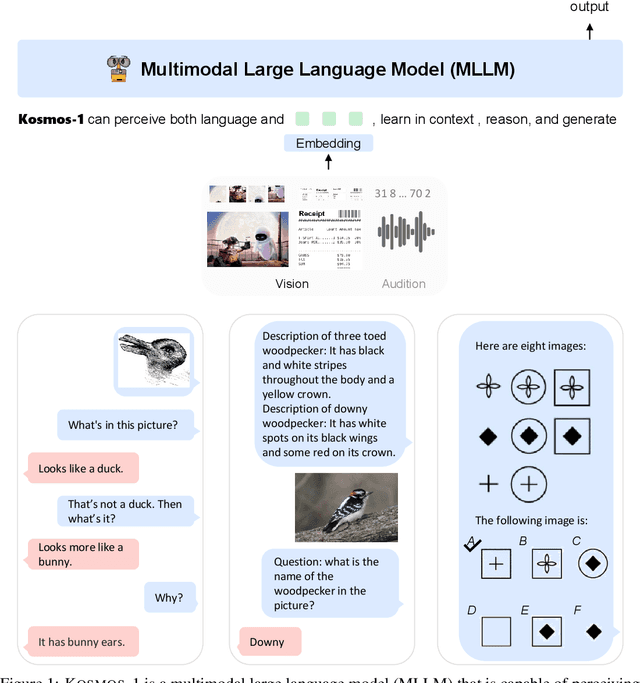
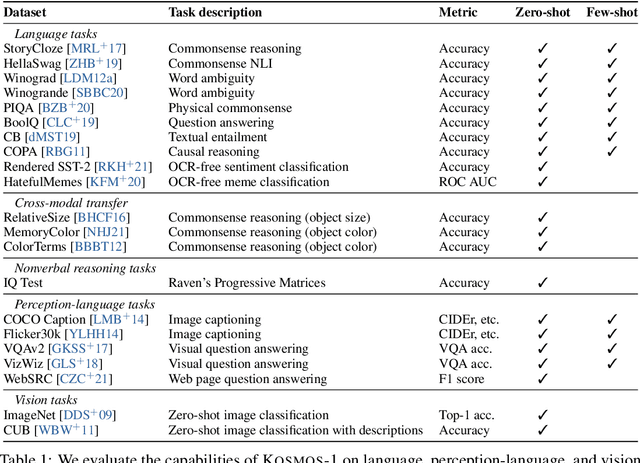
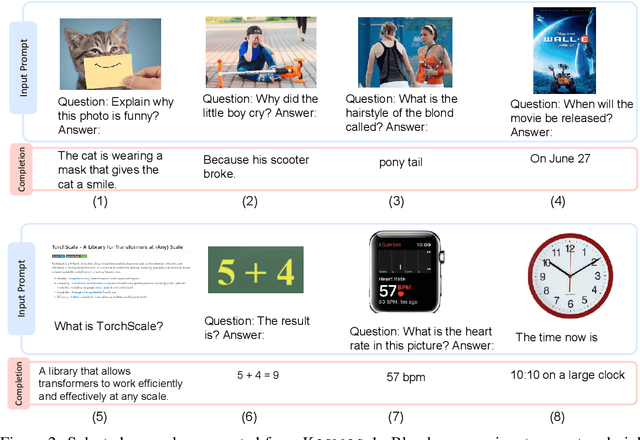
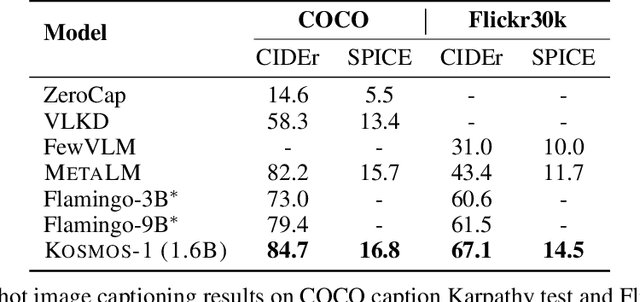
Abstract:A big convergence of language, multimodal perception, action, and world modeling is a key step toward artificial general intelligence. In this work, we introduce Kosmos-1, a Multimodal Large Language Model (MLLM) that can perceive general modalities, learn in context (i.e., few-shot), and follow instructions (i.e., zero-shot). Specifically, we train Kosmos-1 from scratch on web-scale multimodal corpora, including arbitrarily interleaved text and images, image-caption pairs, and text data. We evaluate various settings, including zero-shot, few-shot, and multimodal chain-of-thought prompting, on a wide range of tasks without any gradient updates or finetuning. Experimental results show that Kosmos-1 achieves impressive performance on (i) language understanding, generation, and even OCR-free NLP (directly fed with document images), (ii) perception-language tasks, including multimodal dialogue, image captioning, visual question answering, and (iii) vision tasks, such as image recognition with descriptions (specifying classification via text instructions). We also show that MLLMs can benefit from cross-modal transfer, i.e., transfer knowledge from language to multimodal, and from multimodal to language. In addition, we introduce a dataset of Raven IQ test, which diagnoses the nonverbal reasoning capability of MLLMs.
Why Can GPT Learn In-Context? Language Models Secretly Perform Gradient Descent as Meta-Optimizers
Dec 21, 2022



Abstract:Large pretrained language models have shown surprising In-Context Learning (ICL) ability. With a few demonstration input-label pairs, they can predict the label for an unseen input without additional parameter updates. Despite the great success in performance, the working mechanism of ICL still remains an open problem. In order to better understand how ICL works, this paper explains language models as meta-optimizers and understands ICL as a kind of implicit finetuning. Theoretically, we figure out that the Transformer attention has a dual form of gradient descent based optimization. On top of it, we understand ICL as follows: GPT first produces meta-gradients according to the demonstration examples, and then these meta-gradients are applied to the original GPT to build an ICL model. Experimentally, we comprehensively compare the behavior of ICL and explicit finetuning based on real tasks to provide empirical evidence that supports our understanding. The results prove that ICL behaves similarly to explicit finetuning at the prediction level, the representation level, and the attention behavior level. Further, inspired by our understanding of meta-optimization, we design a momentum-based attention by analogy with the momentum-based gradient descent algorithm. Its consistently better performance over vanilla attention supports our understanding again from another aspect, and more importantly, it shows the potential to utilize our understanding for future model designing.
Optimizing Prompts for Text-to-Image Generation
Dec 19, 2022



Abstract:Well-designed prompts can guide text-to-image models to generate amazing images. However, the performant prompts are often model-specific and misaligned with user input. Instead of laborious human engineering, we propose prompt adaptation, a general framework that automatically adapts original user input to model-preferred prompts. Specifically, we first perform supervised fine-tuning with a pretrained language model on a small collection of manually engineered prompts. Then we use reinforcement learning to explore better prompts. We define a reward function that encourages the policy to generate more aesthetically pleasing images while preserving the original user intentions. Experimental results on Stable Diffusion show that our method outperforms manual prompt engineering in terms of both automatic metrics and human preference ratings. Moreover, reinforcement learning further boosts performance, especially on out-of-domain prompts. The pretrained checkpoints are available at https://aka.ms/promptist. The demo can be found at https://aka.ms/promptist-demo.
Structured Prompting: Scaling In-Context Learning to 1,000 Examples
Dec 13, 2022Abstract:Large language models have exhibited intriguing in-context learning capability, achieving promising zero- and few-shot performance without updating the parameters. However, conventional in-context learning is usually restricted by length constraints, rendering it ineffective to absorb supervision from a large number of examples. In order to go beyond few shots, we introduce structured prompting that breaks the length limit and scales in-context learning to thousands of examples. Specifically, demonstration examples are separately encoded with well-designed position embeddings, and then they are jointly attended by the test example using a rescaled attention mechanism. So we can scale the number of exemplars with linear complexity instead of quadratic complexity with respect to length. Experimental results on a diverse set of tasks show that our approach improves end-task performance and reduces evaluation variance over conventional in-context learning as the number of demonstration examples increases. Code has been released at https://aka.ms/structured-prompting.
Prototypical Fine-tuning: Towards Robust Performance Under Varying Data Sizes
Nov 24, 2022



Abstract:In this paper, we move towards combining large parametric models with non-parametric prototypical networks. We propose prototypical fine-tuning, a novel prototypical framework for fine-tuning pretrained language models (LM), which automatically learns a bias to improve predictive performance for varying data sizes, especially low-resource settings. Our prototypical fine-tuning approach can automatically adjust the model capacity according to the number of data points and the model's inherent attributes. Moreover, we propose four principles for effective prototype fine-tuning towards the optimal solution. Experimental results across various datasets show that our work achieves significant performance improvements under various low-resource settings, as well as comparable and usually better performances in high-resource scenarios.
Language Models are General-Purpose Interfaces
Jun 13, 2022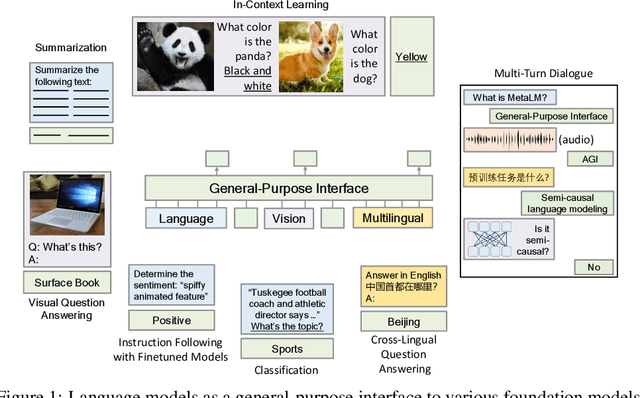

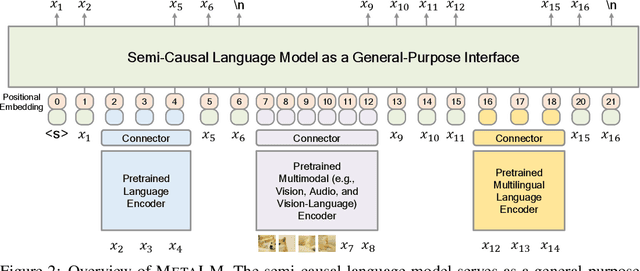
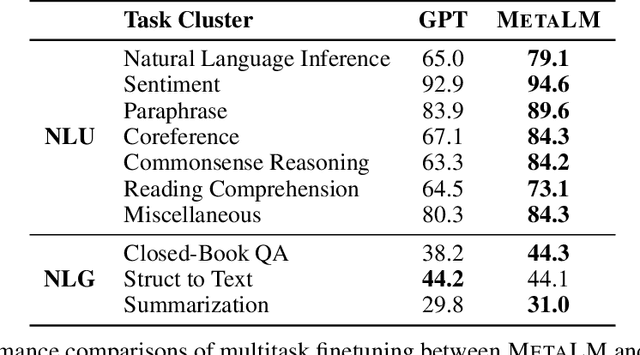
Abstract:Foundation models have received much attention due to their effectiveness across a broad range of downstream applications. Though there is a big convergence in terms of architecture, most pretrained models are typically still developed for specific tasks or modalities. In this work, we propose to use language models as a general-purpose interface to various foundation models. A collection of pretrained encoders perceive diverse modalities (such as vision, and language), and they dock with a language model that plays the role of a universal task layer. We propose a semi-causal language modeling objective to jointly pretrain the interface and the modular encoders. We subsume the advantages and capabilities from both causal and non-causal modeling, thereby combining the best of two worlds. Specifically, the proposed method not only inherits the capabilities of in-context learning and open-ended generation from causal language modeling, but also is conducive to finetuning because of the bidirectional encoders. More importantly, our approach seamlessly unlocks the combinations of the above capabilities, e.g., enabling in-context learning or instruction following with finetuned encoders. Experimental results across various language-only and vision-language benchmarks show that our model outperforms or is competitive with specialized models on finetuning, zero-shot generalization, and few-shot learning.
 Add to Chrome
Add to Chrome Add to Firefox
Add to Firefox Add to Edge
Add to Edge